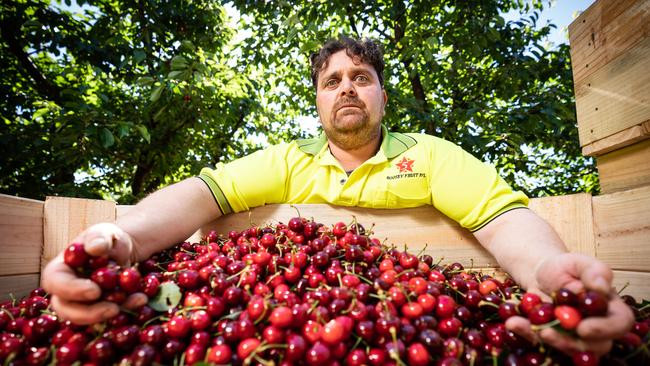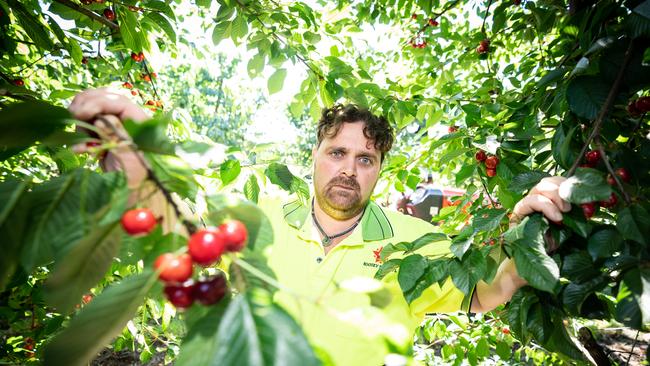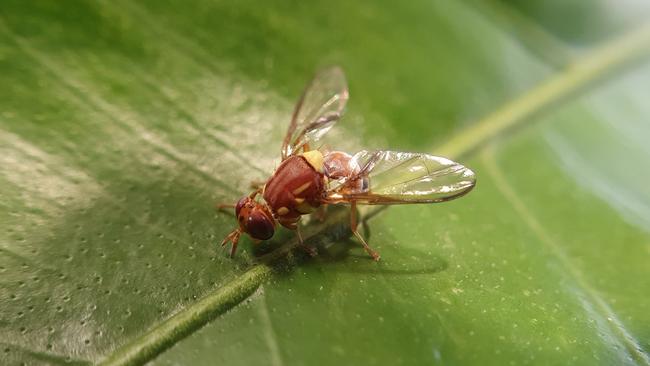Fruit fly stalemate as Vic govt winds back funding
The Victorian government wants growers to pay for fruit fly management from 2025. Grower groups say they can’t.

Victoria
Don't miss out on the headlines from Victoria. Followed categories will be added to My News.
In Victoria’s irrigated horticultural districts of the Goulburn, Murray and Yarra valleys, small, highly trained teams have spent six years tracking and stamping out outbreaks of one of Australia’s most expensive pests: the Queensland fruit fly.
Growers see the groups, funded by the Victorian government, as offering a crucial line of defence against a pest that threatens $1.4 billion of horticultural exports in a state that produces 90 per cent of Australia’s peaches, 85 per cent of nectarines and 50 per cent of its apples.
But grant application guidelines provided to the groups earlier this year made clear no government funding was guaranteed beyond June 2025. The groups were asked instead to use a total funding pool of $2.29 million to transition to an industry and grower funding model over the next two years.
For Cobram and District Fruit Growers president Tony Siciliano, the withdrawal of funding could mean the reversal of years of hard work.
“If the government stopped (funding) in 2025 this program, all of a sudden (numbers will boom in) the places that us farmers can’t reach — in the backyards — then it’s going to bring pressure on neighbouring orchards and then slowly will spread,” he said.
In the Goulburn Valley, the fruit fly management group has brought together five local councils, grower groups such as Fruit Growers Victoria and the Cobram and District Fruit Growers Association, and local volunteers from the Lions Club.

It offers basic free services such as monitoring fruit fly traps, distributing insect netting to backyard fruit growers and removing infested fruit trees.
Without government funding, Mr Siciliano said growers would not be able to fund and co-ordinate all the group’s activities.
“(Fruit fly numbers) aren’t too bad at the minute, due to the good work that we’ve done with the program. The program has basically cut numbers down in Shepparton, Cobram and the main towns (in the Goulburn Valley),” Mr Siciliano said.
“We’ve come so far, and we haven’t come this far just to get this far.
“The government would be silly to take to take any money away.”
Not far from Melbourne, in Victoria’s Yarra Valley, the area-wide fruit fly management group has so far succeeded in quickly detecting and containing any fruit fly incursions.
This year, the group has picked up 35 incursions of fruit fly in the area — higher than previous years — but has managed to stamp out each one.
Yarra Valley Queensland Fruit Fly Awareness and Prevention Project regional co-ordinator Bronwyn Koll said growers and industry groups were still trying to work out if they could continue the group’s work if government funding stopped.
But in northwest Victoria, representatives of the citrus, table grape, and stone fruit industries have made clear growers will not take over funding fruit fly management.

“Without government support, community-based programs to address off-farm fruit fly risk creators will end,” the Fruit Fly Murray Valley regional advisory group wrote in a policy statement provided to the Weekly Times.
“The only practical way for area-wide management to continue to occur is through a state or national co-ordinated funding mechanism.”
In the policy statement, the advisory group took aim at the fruit fly sterilisation initiative, saying it was not ready to fill the gap if the community group folded.
“No clear direction or leadership has emerged from large programs such as Sterile Insect Technology, and … this technology still requires not only a significant long term financial investment but also considerable time to implement,” the group wrote.
The policy statement pointed to the Intergovernmental Agreement on Biosecurity, which identifies states and territories as responsible for managing established pests and diseases.
The Murray Valley region, also known as Sunraysia, which borders NSW and South Australia, has received $5 million from the state government over eight years to control the pest. Growers say they have chipped in $1.9 million.
For South Australian growers, a political skirmish across the border in Victoria risks weakening their defences against the pest and threatens $1.3 billion of horticultural production.
“Fruit fly is not established in South Australia and given the significant financial commitment that the state government continues to make to eradicate the pest in the SA Riverland, any effort interstate which helps to reduce pest pressure is welcomed,” South Australian Agriculture Minister Clare Scriven said in a statement.
“Pest pressure at the South Australian borders is always a concern so I would encourage the Victorian community to continue to do whatever they can to manage the pest, which will also continue to provide benefit to their own growers.”
An Agriculture Victoria spokesperson said: “The Victorian Government has supported regional fruit fly programs since 2017, with over $11.83 million provided in grants to the Yarra Valley, Goulburn Murray Valley and Greater Sunraysia so far and an additional $2.29 million to be provided in 2023-2025.”
The department referenced export data showing Victorian exports had grown from $1.2 billion in 2015/2016 to $1.37 billion in 2021/2022 to support the idea that “Victoria’s horticulture sector has demonstrated the ability to effectively operate in the presence of Queensland fruit fly”.
More Coverage
Originally published as Fruit fly stalemate as Vic govt winds back funding





